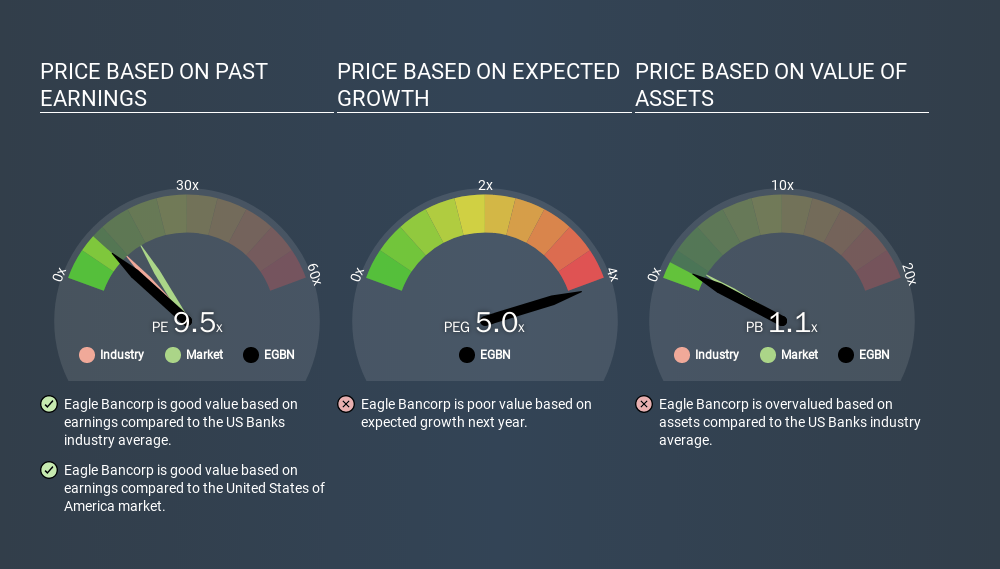Stock Analysis
- United States
- /
- Banks
- /
- NasdaqCM:EGBN
Read This Before You Buy Eagle Bancorp, Inc. (NASDAQ:EGBN) Because Of Its P/E Ratio

Today, we'll introduce the concept of the P/E ratio for those who are learning about investing. We'll look at Eagle Bancorp, Inc.'s (NASDAQ:EGBN) P/E ratio and reflect on what it tells us about the company's share price. Eagle Bancorp has a P/E ratio of 9.50, based on the last twelve months. That corresponds to an earnings yield of approximately 10.5%.
See our latest analysis for Eagle Bancorp
How Do I Calculate A Price To Earnings Ratio?
The formula for price to earnings is:
Price to Earnings Ratio = Share Price ÷ Earnings per Share (EPS)
Or for Eagle Bancorp:
P/E of 9.50 = $39.720 ÷ $4.182 (Based on the year to December 2019.)
(Note: the above calculation results may not be precise due to rounding.)
Is A High Price-to-Earnings Ratio Good?
A higher P/E ratio implies that investors pay a higher price for the earning power of the business. All else being equal, it's better to pay a low price -- but as Warren Buffett said, 'It's far better to buy a wonderful company at a fair price than a fair company at a wonderful price'.
Does Eagle Bancorp Have A Relatively High Or Low P/E For Its Industry?
The P/E ratio indicates whether the market has higher or lower expectations of a company. We can see in the image below that the average P/E (11.9) for companies in the banks industry is higher than Eagle Bancorp's P/E.

Eagle Bancorp's P/E tells us that market participants think it will not fare as well as its peers in the same industry. Since the market seems unimpressed with Eagle Bancorp, it's quite possible it could surprise on the upside. You should delve deeper. I like to check if company insiders have been buying or selling.
How Growth Rates Impact P/E Ratios
Earnings growth rates have a big influence on P/E ratios. When earnings grow, the 'E' increases, over time. That means even if the current P/E is high, it will reduce over time if the share price stays flat. And as that P/E ratio drops, the company will look cheap, unless its share price increases.
Eagle Bancorp shrunk earnings per share by 5.8% last year. But EPS is up 16% over the last 5 years.
Don't Forget: The P/E Does Not Account For Debt or Bank Deposits
One drawback of using a P/E ratio is that it considers market capitalization, but not the balance sheet. In other words, it does not consider any debt or cash that the company may have on the balance sheet. In theory, a company can lower its future P/E ratio by using cash or debt to invest in growth.
Such expenditure might be good or bad, in the long term, but the point here is that the balance sheet is not reflected by this ratio.
How Does Eagle Bancorp's Debt Impact Its P/E Ratio?
Eagle Bancorp's net debt is 21% of its market cap. It would probably deserve a higher P/E ratio if it was net cash, since it would have more options for growth.
The Verdict On Eagle Bancorp's P/E Ratio
Eagle Bancorp's P/E is 9.5 which is below average (16.8) in the US market. The debt levels are not a major concern, but the lack of EPS growth is likely weighing on sentiment.
Investors should be looking to buy stocks that the market is wrong about. If the reality for a company is not as bad as the P/E ratio indicates, then the share price should increase as the market realizes this. So this free visualization of the analyst consensus on future earnings could help you make the right decision about whether to buy, sell, or hold.
You might be able to find a better buy than Eagle Bancorp. If you want a selection of possible winners, check out this free list of interesting companies that trade on a P/E below 20 (but have proven they can grow earnings).
If you spot an error that warrants correction, please contact the editor at editorial-team@simplywallst.com. This article by Simply Wall St is general in nature. It does not constitute a recommendation to buy or sell any stock, and does not take account of your objectives, or your financial situation. Simply Wall St has no position in the stocks mentioned.
We aim to bring you long-term focused research analysis driven by fundamental data. Note that our analysis may not factor in the latest price-sensitive company announcements or qualitative material. Thank you for reading.
About NasdaqCM:EGBN
Eagle Bancorp
Operates as the bank holding company for EagleBank that provides commercial and consumer banking services primarily in the United States.
Very undervalued with flawless balance sheet and pays a dividend.

